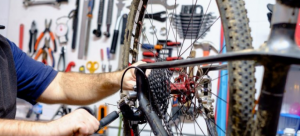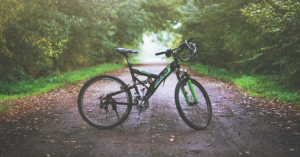How to prepare a bike for storage – step by step instructions
Proper preparation consists of several stages. All of them are simple, but require care. These stages of preparation are equally suitable for storage in warm home conditions, and for harsh storage in an unheated garage or loggia. However, sub-zero temperatures and high humidity have a very bad effect on rubber, mechanisms, and the frame. Even the most thorough preparation will not save in this case from the appearance of rust on the metal and cracks on the tires.

Chain release
Stages of preparation
- We start with washing. Wash the bike gently under a small stream of water with a soft cloth. Never submerge the entire bike in water, otherwise water will get into the frame, which can cause corrosion. Thoroughly wash the dirt from the frame, wheels, fenders, chain and all its gears and sprockets.
- Drying. After washing, go over all parts of the bike with a dry cloth and wait until it is completely dry. Before winter storage, it must be clean and dry, as the remaining dirt or moisture will instantly give the green light to corrosion, which will then be very difficult to fight.
- Lubricant renewal. Lubricate the cleaned chain and bushings with special bicycle grease. Do not apply too thickly, an even thin layer will suffice, always remove excess with a dry cloth.
- Inspection and minor repairs. This part of the preparation requires maximum attention: inspect all parts, levers, mechanisms for faults or cracks. If somewhere something does not work well, does not open, jams or makes strange sounds, be sure to fix the minor damage yourself or give it to the master for repair.
- Loose chain tension. The chain must be put in position on the smallest stars in front and behind. In this position, the rear derailleur has the least load, and the chain is not under tension. By the way, this can be done not only to prepare the bike for winter storage, but every time after the trip.
- The pressure in the chambers must be reduced to 1-1.5 atmospheres. With this pressure, the bike does not stand on the rims, and the tires themselves compress easily. Even if the bike is to be stored suspended, do not keep the tires completely flat or fully inflated.
- Silicone lubricant for rubber. If you store the bike in the cold – on the balcony or in a cold garage, then be sure to lubricate the rubber with a special lubricant. It must be applied not only to tires, but also to chrome parts, scratches and chips.
- Silicone grease will protect the metal from corrosion and the paint from cracking.
- Remove all electronics from the bike – navigator, bike computer, remove all batteries and accumulators from the lights so that they do not run out and leak.
- Loosen the seatpost, handlebar, and stem clamps on a carbon bike to relieve pressure on the carbon.
- Release the tension on the springs and cables of the derailleurs, disc and V-brake brakes. Disconnect the brake levers to loosen the tension on the springs.

- Loosen mounting screws if disc brakes are installed.
- Suspension fork lubrication. Lubricate the cleaned chain and bushings with special bicycle grease, applying it in a uniform thin layer. After that, pump the plug several times as much as possible and leave it for 10-15 minutes. During this time, the oil will drain down to the seals. Wipe off excess with a rag.
If your bike has an air or oil-air suspension fork, reduce the pressure. - Now in a case? Yes! The bike in the case is protected from dust, which means that the chain mechanisms will remain as clean as possible. If there is no cover, then you can wrap the bike with stretch film. In general, this is not a necessary condition if you are going to store the bike in a warm, clean and ventilated area.
- If you want to store the bike as safely as possible so that no pressure is applied to its working units, then it is better to hang it on special mounts. This can be done either by the wheel, in which case the bike will be stored vertically, or by the frame, in which case it will hang horizontally. When suspended, there is no load on the wheels and frame, so we keep the bike as new as possible.
